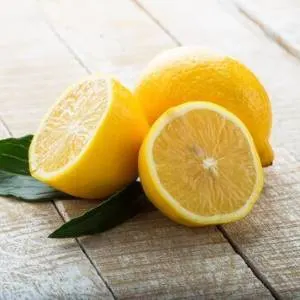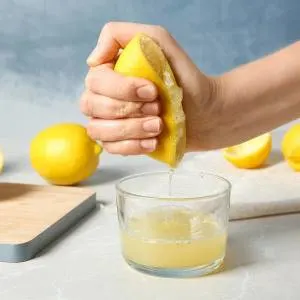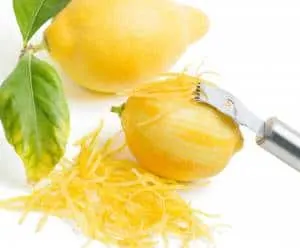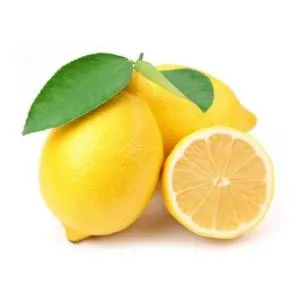 Recipes often say that you should add the juice of one lemon, or the amount of lemon juice you need is indicated in tablespoons. But there is quite a difference in the size and juiciness of these tasty citrus fruits, and what if you only have a bottle of lemon juice?
Recipes often say that you should add the juice of one lemon, or the amount of lemon juice you need is indicated in tablespoons. But there is quite a difference in the size and juiciness of these tasty citrus fruits, and what if you only have a bottle of lemon juice?
For example, the juice of a small lemon can make your recipe very sweet and less sour, while a very large juicy lemon makes your recipe thinner and more acidic.
I always take into account the juice and zest of an average lemon in my recipes. The average lemon size for me is about 5 oz. But even if you know the size of your lemon, how do you work out how much juice in one lemon?
Read More: 9 benefits of lemon peel
How much juice in one lemon – a rough guide
Usually, recipes will call for lemon juice to be measured in tablespoons, so the guide below will give you a good idea of what you need depending on the size of your lemons.
Lemon juice guide
How much juice in one lemon:
1 small lemon = 3 tablespoons of lemon juice
1 medium lemon = 4 tablespoons of lemon juice
1 large lemon = 5 tablespoons of lemon juice
If a recipe calls for the juice of one lemon and you only have a bottle of lemon juice, then you know that you will need between 3 – 5 tablespoons. I usually just go down the middle and add 4 tablespoons.
Lemon zest guide
If a recipe calls for the zest of one lemon, once again it depends on the size of your lemon. How much lemon zest do you get from the rind of one lemon?
How much zest in one lemon:
1 small lemon = 1 tablespoon of lemon zest
1 medium lemon = 2 tablespoons of lemon zest
1 large lemon = 3 tablespoons of lemon zest
I usually squeeze a lemon by hand. This is easier (less washing up) and with a citrus juicer, you run the risk of scraping too much into the peel, making your juice bitter. This is also very important when grating the skin: make sure you don’t grate the white because that tastes super bitter.
Read More: How to make lemon sorbet in a Vitamix
How to juice a lemon
 You use fresh lemon juice in many dishes and recipes. But how do you make sure you have all the juice from each lemon? Follow the tips below to get the most juice out of your lemon.
You use fresh lemon juice in many dishes and recipes. But how do you make sure you have all the juice from each lemon? Follow the tips below to get the most juice out of your lemon.
Juice a lemon by hand
Various methods are circulating on the internet to get more juice from your lemon. It is claimed that if you cut your lemon vertically instead of horizontally, it will release up to 3 times more juice.
We put it to the test and discovered that it makes very little difference how you cut it. What does matter: the temperature! Follow these best practices before you juice a lemon:
- Store your lemons at room temperature.
- Put the lemon in the microwave for a maximum of 20 seconds.
- Warm the lemon up by rolling it over the counter with your flat hand.
- Place the lemon in a bowl of warm water.
You can use any of the tips above, they are all trying to achieve the same thing. By warming a lemon, it makes the skin more flexible, making it easier to squeeze juice from the fruit. The softer they are, the better you can squeeze them.
Once you have warmed and softened the lemon, cut it in half, and squeeze the juice into a bowl.
If you don’t want seeds in your juice, you can wrap half a lemon in a cheesecloth or piece of gauze. I usually don’t bother with this extra step as you can just scoop the seeds out of the juice with a slotted spoon.
Read More: 23 simple juice recipes
How to zest a lemon
 A little lemon zest works wonders. It gives a dish just that little bit of flavor you are looking for.
A little lemon zest works wonders. It gives a dish just that little bit of flavor you are looking for.
Make lemon zest with a regular fine grater or with a special lemon extractor. You then only get the tasty yellow skin as a zest. The white under the skin is bitter and you don’t want that in your recipe.
If you don’t have a grater or lemon extractor, you can also peel a firm lemon with a peeler. Then slice or chop the peels very finely with a kitchen knife.
Tips for the best lemon zest
- Make sure to always use fresh lemons. The peel of old lemons is tough, is difficult to grate, and is no longer as aromatic.
- Always use organic lemons for zest. Organic lemons do not have a protective wax layer, which you have to thoroughly polish off first.
Read More: Does lemon juice go bad?
Lemon information and facts
 Lemons (Citrus Limon) are one of the citrus fruits. They grow on trees that bear fruit up to 4 times a year.
Lemons (Citrus Limon) are one of the citrus fruits. They grow on trees that bear fruit up to 4 times a year.
They have yellow skin that varies from pale to deep yellow. The size is up to 10 cm and the shape varies from round to elongated. The fruit contains a lot of vitamin C (35-40 mg per 100 grams of flesh), which makes the lemon quite sour in taste.
Most lemons for the American market come from the USA, although imports are also made from Turkey, Egypt, and Europe.
In culinary terms, lemons, and in particular the juice, are used for fruit drinks and lemonade. Lemon juice is also a popular ingredient in marinades for fish and meat. In addition, lemon juice is used to prevent freshly cut fruit from turning brown due to oxidation.
Lemon marmalade is made from peels, and the peels are also the flavoring ingredient in a number of distilled drinks. Grated lemon zest is added to pastries and desserts as a seasoning.
Lemon wedges or slices are used as a garnish, both for food and drinks.
Lemons are also canned, especially Moroccan cuisine has many uses for canned lemons.
Lemon varieties
There are quite a few varieties of lemons on the market, but they are rarely if ever offered under their own name. Some of those varieties are:
- Eureka (ovoid to elongated oval, few seeds)
- Femminello (round with a nose, few seeds, basis for Limoncello)
- Hermosa (elongated oval, sometimes slightly ovoid, deep yellow, few to no seeds)
- Lisbon (dark yellow, oval, or round with a nose)
- Primofiori (oval, yellow with sometimes a trace of green, very juicy)
- Verna (convex, elongated fruit, deep yellow, seedless, juicy)
Read More: Are lemon seeds edible?
Lemon facts
- You can wash lemons (and citrus fruit in general) as follows: Place the fruit in a container with warm water to which a little mild detergent has been added. Leave in this water for fifteen minutes and then rinse well with cold water.
- You get the most juice when the lemon is placed in warm water for a few minutes just before pressing and then rolled back and forth with some pressure. Then squeeze by hand or with a citrus press.
- If you want the lemon zest, use a vegetable peeler or grater. Be careful not to peel or grate the white as it is bitter.
- Lemon zest can be mixed with sugar and kept in the fridge as a seasoning for pastries.
Read More: What is the best blender for vegan food?
